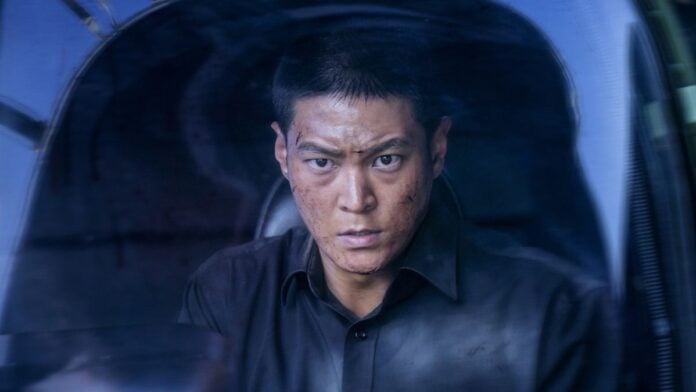Single-take movies or sequences, by definition, appear as one take. The camera focuses on disparate elements within the frame by which separate shots are edited together, or camera movements are maneuvered discreetly so that the editing can be hidden. Or the simplest of options – shoot the sequences in the dark so that it is impossible to make out the editing of the separate shots. At this point, when movies like Sam Mendes’ 1917, James Nunn’s One Shot, and not to mention innumerable one-shot action sequences in other movies like David Leitch’s Atomic Blonde, exist, it is abundantly clear that the secret sauce of making a single-take film is to ensure that the editing remains discreet. The appearance of the single take matters, and the aesthetic value of this single take is further heightened because the sequence is shot without utilizing shaky cam, or without the camera roaming about throughout the room trying to capture wider shots of the carnage. Single-take movies are supposed to exercise technical proficiency, restraint, and steady filmmaking. These are features completely absent in “Carter.”
The plot of “Carter” is a mash-up of various genres thrown together in a blender to make a sludge of a film. The synopsis on Netflix’s official site states that the film is about a man who wakes up without any prior memories. The man hears a mysterious voice in his ears that convinces him to carry out a hostage rescue mission that is obviously going to be filled with dangers. It is less than a tenth of the movie’s plot, which involves a mysterious espionage mission caused by strife between North and South Korea, which has already courted interested parties like the CIA, and that is all connected to a pandemic that has originated from the DMZ, suspected to be caused by a virus released by a fringe organization within the North Korean ranks. The virus also causes people to behave in a zombie-like manner. There is also Carter’s own missing identity, a kidnapping that he has to thwart, and that is nothing compared to the action sequences.
The single-take feature of the film is the furthest thing from being discreet. On the contrary, the editing of the different scenes to maintain the illusion of a single sequence is so obvious that you would be forgiven for wondering whether a framerate was skipped. If you are wondering whether the zoomed-in frame of Carter hiding behind a bus feels significantly more computer-generated than the actual shot, that is because it is computer-generated. The action scenes in “Carter” are a mix of visceral violence where the blood is digitized; drone cameras zooming through an entire area; shaky cams trying hard to capture all the moves of the hand-to-hand combat; and action scenes shot with a green screen background, evoking the feeling of watching a fight against poorly rendered special effects. All these differing forms of action “spectacle” are then poorly spliced together, such that they barely evoke the feeling of watching a single take. It just begs the question—why not just do a normally edited action film? As showcased in this Netflix original, “Carter” would be praised for being an ambitious spectacle if it was viewed as a fan film or a YouTube experiment, but as a movie being advertised as a Netflix original, it feels like a huge misfire. Consider a direct-to-video film like One Shot. It employs minimal CGI and adheres to the fundamental tenet of a single-take action film-the action sequences are well executed, giving the gimmick a fine execution. In movies like these, the stories tend to be simple, so the focus lies in the execution of the gimmick. “Carter” also suffers because of a complicated plot consisting of haphazard splicing of different genres, resulting in a slapdash execution. It’s not a coincidence that the one-take sequences in the movie are most effective when the camera remains steady while conversations are occurring. It is laughable during moments where collisions occur, and characters are supposed to fly out of their cars or their vehicles and hit the pavement, or barely miss. The transition from a human body to a rubbery CGI model is exceedingly visible and extremely jarring.
It would have been salvageable if “Carter” managed to flesh out or elicit some level of emotion from its protagonists or supporting cast. But other than Joo-Won’s stoic acting as the secret agent Carter, who has lost his memory and is now on a mission to regain it, there isn’t much of a performance that leaves a mark. It might be because, after the tenth or twelfth poorly edited or rendered action sequence, the emotional sequences just fail to connect, even as the action scenes grow significantly larger and more ridiculous in scope. The final sequence, consisting of two helicopters, a train, and a jeep, is a sight to behold, if only to realize what it could have been if executed better and the director had abandoned the single-take gimmick. There is even a tease at the end for a sequel, which feels more audacious than the movie itself. In hindsight, calling “Carter” a parody of a single-take action sequence-heavy film would be a gross misconception because a parody, by its definition, is a tongue-in-cheek endeavor. It is the complete opposite of the film’s sincerity in appearing as a serious and cool action movie but failing miserably, not because of the low-budget CGI, but because ambition trumped competency and style completely brushed over the substance.
“Carter” is a 2022 South Korean Action Thriller film streaming on Netflix with subtitles.

